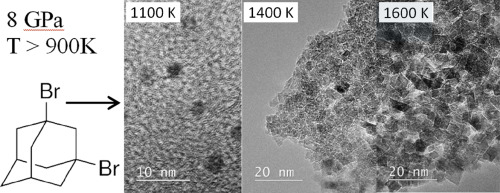当前位置:
X-MOL 学术
›
Diam. Relat. Mater.
›
论文详情
Our official English website, www.x-mol.net, welcomes your
feedback! (Note: you will need to create a separate account there.)
High-pressure synthesis and optical properties of nanodiamonds obtained from halogenated adamantanes
Diamond and Related Materials ( IF 4.3 ) Pub Date : 2020-03-01 , DOI: 10.1016/j.diamond.2020.107718 E.A. Ekimov , M.V. Kondrin , S.G. Lyapin , Yu.V. Grigoriev , A.A. Razgulov , V.S. Krivobok , S. Gierlotka , S. Stelmakh
Diamond and Related Materials ( IF 4.3 ) Pub Date : 2020-03-01 , DOI: 10.1016/j.diamond.2020.107718 E.A. Ekimov , M.V. Kondrin , S.G. Lyapin , Yu.V. Grigoriev , A.A. Razgulov , V.S. Krivobok , S. Gierlotka , S. Stelmakh

|
Abstract Following our previous brief communication the carbonization of halogenated adamantanes C10H14Br2 and C10H15Cl under high pressure with the aim to produce nanodiamonds have been studied in details. A fixed pressure of 8 GPa and temperatures up to 2000 K were applied. Carbonization behavior of both precursors is very similar and starts in range of 900–1000 K with formation of about 1–2 nm diamond nanocrystals. With increasing process temperature the size of obtained nanodiamonds slowly grows up to tens of nanometers at 2000 K. The observed behavior provides favorable conditions for the synthesis of the nanodiamonds of the precisely controlled crystal size. Raman spectroscopy, X-ray diffraction and high resolution transmission microscopy were used to monitor the phase composition of the samples and the crystal size of nanodiamonds. Lattice parameter of nanodiamonds, calculated by using the Rietveld analysis of the X-ray diffraction patterns, increases by up to 2–3% as an average crystallite size decreases to the minimal value of 1–2 nm. Based on the experimental results and density functional theory calculations, extremely high increase in the lattice parameter of nanodiamonds is interpreted in terms of the strain exerted on the nanocrystals due to diamond surface reconstruction, particularly on the (110) face. Lowering of the crystal size is accompanied by the red-shift and broadening of the diamond Raman line. The effects are explained in terms of the crystal lattice expansion and the phonon confinement model.
中文翻译:

卤化金刚烷纳米金刚石的高压合成及光学性质
摘要 根据我们之前的简短交流,我们详细研究了卤化金刚烷 C10H14Br2 和 C10H15Cl 在高压下碳化以制备纳米金刚石。施加了 8 GPa 的固定压力和高达 2000 K 的温度。两种前驱体的碳化行为非常相似,在 900-1000 K 范围内开始形成约 1-2 nm 的金刚石纳米晶体。随着工艺温度的升高,获得的纳米金刚石的尺寸在 2000 K 时缓慢增长至数十纳米。观察到的行为为合成精确控制晶体尺寸的纳米金刚石提供了有利条件。拉曼光谱、X 射线衍射和高分辨率透射显微镜用于监测样品的相组成和纳米金刚石的晶体尺寸。通过使用 X 射线衍射图的 Rietveld 分析计算出的纳米金刚石的晶格参数增加了 2-3%,因为平均微晶尺寸减小到 1-2 nm 的最小值。根据实验结果和密度泛函理论计算,纳米金刚石晶格参数的极大增加被解释为由于金刚石表面重构而施加在纳米晶体上的应变,特别是在 (110) 面上。晶体尺寸的降低伴随着金刚石拉曼谱线的红移和加宽。根据晶格膨胀和声子限制模型来解释这些效应。随着平均微晶尺寸减小到 1-2 nm 的最小值,增加了 2-3%。根据实验结果和密度泛函理论计算,纳米金刚石晶格参数的极大增加被解释为由于金刚石表面重建而施加在纳米晶体上的应变,特别是在 (110) 面上。晶体尺寸的降低伴随着金刚石拉曼谱线的红移和加宽。根据晶格膨胀和声子限制模型来解释这些效应。随着平均微晶尺寸减小到 1-2 nm 的最小值,增加了 2-3%。根据实验结果和密度泛函理论计算,纳米金刚石晶格参数的极大增加被解释为由于金刚石表面重建而施加在纳米晶体上的应变,特别是在 (110) 面上。晶体尺寸的降低伴随着金刚石拉曼谱线的红移和加宽。根据晶格膨胀和声子限制模型来解释这些效应。纳米金刚石晶格参数的极大增加被解释为由于金刚石表面重建而施加在纳米晶体上的应变,特别是在 (110) 面上。晶体尺寸的降低伴随着金刚石拉曼谱线的红移和加宽。根据晶格膨胀和声子限制模型来解释这些效应。纳米金刚石晶格参数的极大增加被解释为由于金刚石表面重建而施加在纳米晶体上的应变,特别是在 (110) 面上。晶体尺寸的降低伴随着金刚石拉曼谱线的红移和加宽。根据晶格膨胀和声子限制模型来解释这些效应。
更新日期:2020-03-01
中文翻译:

卤化金刚烷纳米金刚石的高压合成及光学性质
摘要 根据我们之前的简短交流,我们详细研究了卤化金刚烷 C10H14Br2 和 C10H15Cl 在高压下碳化以制备纳米金刚石。施加了 8 GPa 的固定压力和高达 2000 K 的温度。两种前驱体的碳化行为非常相似,在 900-1000 K 范围内开始形成约 1-2 nm 的金刚石纳米晶体。随着工艺温度的升高,获得的纳米金刚石的尺寸在 2000 K 时缓慢增长至数十纳米。观察到的行为为合成精确控制晶体尺寸的纳米金刚石提供了有利条件。拉曼光谱、X 射线衍射和高分辨率透射显微镜用于监测样品的相组成和纳米金刚石的晶体尺寸。通过使用 X 射线衍射图的 Rietveld 分析计算出的纳米金刚石的晶格参数增加了 2-3%,因为平均微晶尺寸减小到 1-2 nm 的最小值。根据实验结果和密度泛函理论计算,纳米金刚石晶格参数的极大增加被解释为由于金刚石表面重构而施加在纳米晶体上的应变,特别是在 (110) 面上。晶体尺寸的降低伴随着金刚石拉曼谱线的红移和加宽。根据晶格膨胀和声子限制模型来解释这些效应。随着平均微晶尺寸减小到 1-2 nm 的最小值,增加了 2-3%。根据实验结果和密度泛函理论计算,纳米金刚石晶格参数的极大增加被解释为由于金刚石表面重建而施加在纳米晶体上的应变,特别是在 (110) 面上。晶体尺寸的降低伴随着金刚石拉曼谱线的红移和加宽。根据晶格膨胀和声子限制模型来解释这些效应。随着平均微晶尺寸减小到 1-2 nm 的最小值,增加了 2-3%。根据实验结果和密度泛函理论计算,纳米金刚石晶格参数的极大增加被解释为由于金刚石表面重建而施加在纳米晶体上的应变,特别是在 (110) 面上。晶体尺寸的降低伴随着金刚石拉曼谱线的红移和加宽。根据晶格膨胀和声子限制模型来解释这些效应。纳米金刚石晶格参数的极大增加被解释为由于金刚石表面重建而施加在纳米晶体上的应变,特别是在 (110) 面上。晶体尺寸的降低伴随着金刚石拉曼谱线的红移和加宽。根据晶格膨胀和声子限制模型来解释这些效应。纳米金刚石晶格参数的极大增加被解释为由于金刚石表面重建而施加在纳米晶体上的应变,特别是在 (110) 面上。晶体尺寸的降低伴随着金刚石拉曼谱线的红移和加宽。根据晶格膨胀和声子限制模型来解释这些效应。











































 京公网安备 11010802027423号
京公网安备 11010802027423号